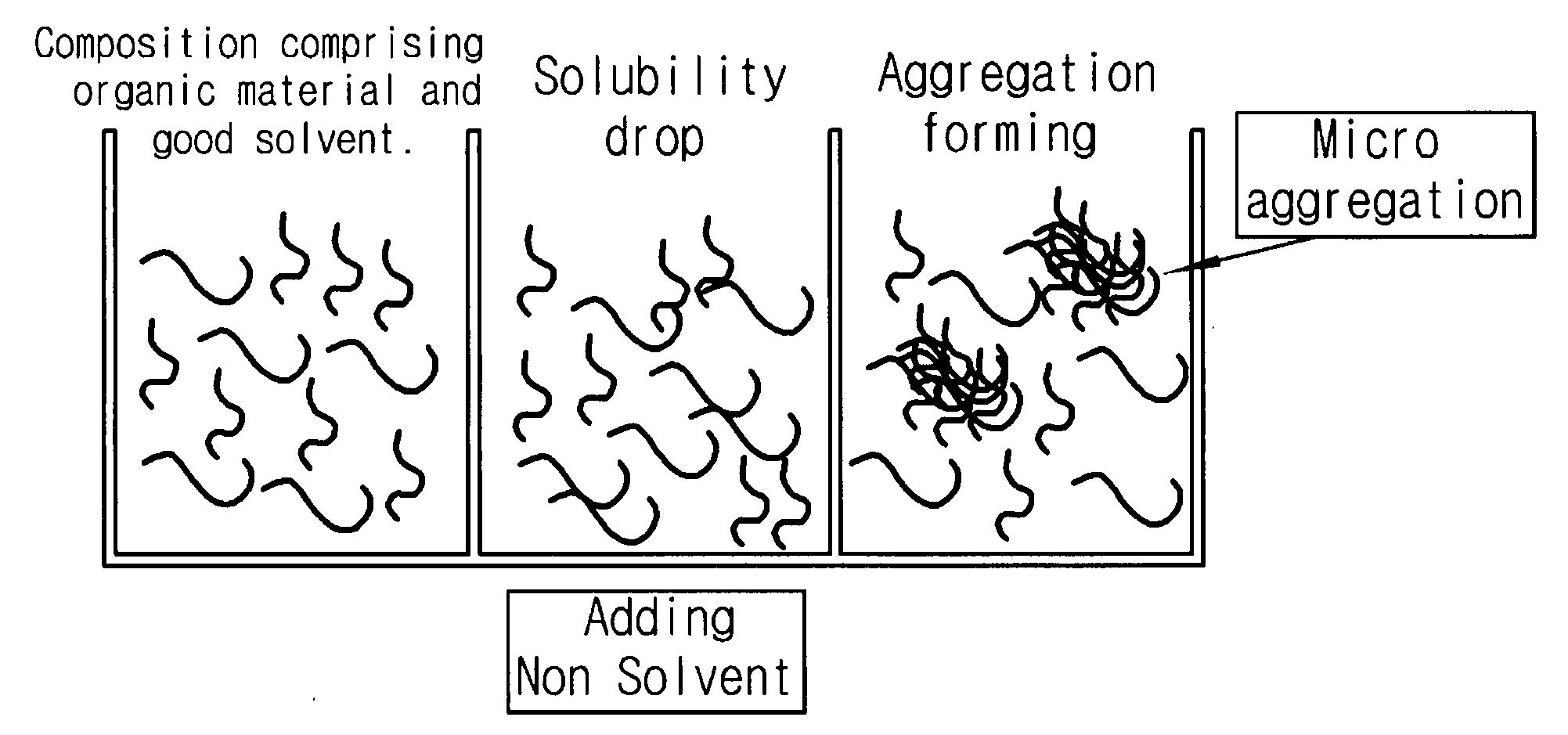Methods for forming an organic thin film using solvent effects, organic thin film formed by the method, and organic electronic device comprising organic thin film
- Summary
- Abstract
- Description
- Claims
- Application Information
AI Technical Summary
Benefits of technology
Problems solved by technology
Method used
Image
Examples
example 1
[0066]About 1 wt % of poly(3-hexylthiophene) (P3HT) (molecular weight: about 33,000) was dissolved in chlorobenzene at about 45° C., and then about 10 parts by volume of acetonitrile was added to the solution. The mixture was dispersed by sonication for about 3 hours to prepare an organic semiconductor composition. A molybdenum / tungsten (Mo / W) alloy was deposited to a thickness of about 1,000 Å on a clean glass substrate by sputtering to form a gate electrode. Then a mixture of the methacryloxypropyltrimethoxysilane polymer and tetrabutoxy titanate (Ti(OC4H9)4)(about 70:30 weight ratio) was dissolved in butanol a concentration of about 10 wt %. The solution was spin-coated to a thickness of about 7,000 Å thereon to form a gate insulating layer. The organic semiconductor composition was spin-cast at about 1,000 rpm to a thickness of about 800 Å on the gate insulating layer, and baked under a nitrogen atmosphere at about 100° C. for about 10 minutes to form a semiconductor layer. Ther...
example 2
[0067]About 1 wt % of poly(3-hexylthiophene) (P3HT) (molecular weight: about 33,000) was dissolved in chlorobenzene at about 45° C., and then about 10 parts by volume of butyl alcohol was added to the solution. The mixture was dispersed by sonication for about 3 hours to prepare an organic semiconductor composition. A molybdenum / tungsten (Mo / W) alloy was deposited to a thickness of about 1,000 Å on a clean glass substrate by sputtering to form a gate electrode, and then an organic insulator material was spin-coated to a thickness of about 7,000 Å thereon to form a gate insulating layer. As the organic insulator material, the same material as that used in Example 1 was used. The organic semiconductor composition was spin-cast at about 1,000 rpm to a thickness of about 800 Å on the gate insulating layer, and baked under a nitrogen atmosphere at about 100° C. for about 10 minutes to form a semiconductor layer. Thereafter, gold (Au) was deposited to a thickness of about 700 Å on the sem...
example 3
[0068]About 1 wt % of poly(3-hexylthiophene) (P3HT) (molecular weight: about 33,000) was dissolved in chlorobenzene at about 45° C. and dispersed by sonication for about 3 hours to prepare an organic semiconductor composition. A molybdenum / tungsten (Mo / W) alloy was deposited to a thickness of about 1,000 Å on a clean glass substrate by sputtering to form a gate electrode, and then an organic insulator material was spin-coated to a thickness of about 7,000 Å thereon to form a gate insulating layer. As the organic insulator material, the same material as that used in Example 1 was used. A predetermined or given amount of the organic semiconductor composition was drop-cast on the gate insulating layer. Before evaporation of the solvent, butyl alcohol was dropped on the organic semiconductor composition. The butyl alcohol was used in an amount of about 10% by volume, based on the volume of the composition. The resulting structure was baked under a nitrogen atmosphere at about 100° C. fo...
PUM
 Login to View More
Login to View More Abstract
Description
Claims
Application Information
 Login to View More
Login to View More - R&D
- Intellectual Property
- Life Sciences
- Materials
- Tech Scout
- Unparalleled Data Quality
- Higher Quality Content
- 60% Fewer Hallucinations
Browse by: Latest US Patents, China's latest patents, Technical Efficacy Thesaurus, Application Domain, Technology Topic, Popular Technical Reports.
© 2025 PatSnap. All rights reserved.Legal|Privacy policy|Modern Slavery Act Transparency Statement|Sitemap|About US| Contact US: help@patsnap.com



